

Waterproof The Roof. 3-5-ETS1-3 Plan and carry out fair tests in which variables are controlled and failure points are considered to identify aspects of a model or prototype that can be improved.
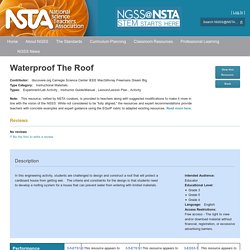
Clarification Statement: none Assessment Boundary: none This resource appears to be designed to build towards this performance expectation, though the resource developer has not explicitly stated so. Comments about Including the Performance Expectation Students place their newly roofed house on a sheet of newspaper for the water test. After the roof is sprayed with water, the students will lift up the house and see if the newspaper underneath became wet.
Projects. Projects. Design Challenges. 630753main NASAsBESTActivityGuide3 5. 630755main NASAsBESTActivityGuideK 2. Simple Lift by Kiwi Crate. With a little imagination and creativity, there are many things that you can create by learning how to make a simple lift!
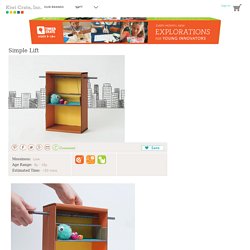
A parking garage, a dollhouse, a make-believe tree house, and an elevator are just a few ideas. If you have some extra crates or boxes to repurpose this Earth Day, give this DIY a try! How We Did It Cut the lid off your crate. We'll use both the base and the lid in our lift construction. Cut a strip of cardboard from the lid, making it slightly narrower than the interior depth of the crate. Next, place the cardboard strip next to the box. Next cut a thin strip from the remaining cardboard lid, about 1 or 2 inches. On the thin strip of cardboard, measure roughly a half inch from each side and punch a hole. Place the wider strip of cardboard on a flat surface with its tabs folded upward. Measure out and cut a length of string that is about twice the height of your crate when it's standing upright. Now that all of your pieces are made, It's time to decorate!
All Ages. Sc1705 29. Siemensstemday. ScratchMath - A Collection of 4th Grade Math Modelers. DESIGN SQUAD GLOBAL Coming Soon . DESIGN SQUAD NATION. 15 Science Experiments You Can Do With Your Kids. By Therese Oneill Time to get messy, light some stuff on fire, and use food products in ways they were never intended!
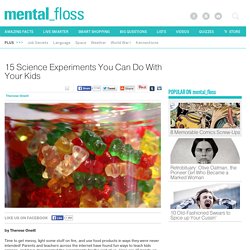
Parents and teachers across the internet have found fun ways to teach kids science, and have documented the experiments for the rest of us. Here are 15 hands-on science lessons that will stick in a kid’s brain far longer than anything they get from a textbook. 1. Lemony Sudsy Eruptions @ Blog Me Mom Fun Quotient: A much less stinky take on the trusty vinegar and baking soda eruptions. Teaches: The baking soda base and the citric acid create an endothermic reaction while releasing carbon dioxide in bubble form. 2. TaxFix.co.uk. For Educators - Curriculum. Asteroid Landers Students will be part of Girlstart's 1st ALL-GIRL Mission to create a vehicle to land and collect minerals on an asteroid.

Girlstart and NASA need help coming up with an asteroid lander design. Download the Asteroid Lander Mission here. Circuits Students create circuits that use buzzers to transfer electrical energy into sound energy. Download the Matter and Energy Circuit Messages Module here. Go Green Helping students understand their environmental impact by learning about different physical properties of plastics. Download the Plastic Pollution in the Ocean Activity here.
Download the Plastic Rescue Mission handout here. Miner Rescue Prototype Students learn about the Chilean miner incident and design a prototype for a piece of equipment that is sturdy and safe to allow for the most efficient rescue. Download the Miner Rescue Prototype Activity here. Activities : Beyond the Chalkboard. Classroom Resources. Sesame Street. VCEC - Design Briefs. Kids Experiments. Search. Properties Everywhere.
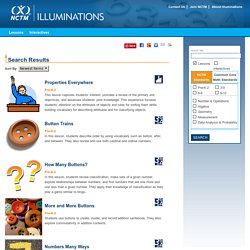
Playdough To Plato - Fun learning activities for kids! Reading, writing, math, science and more. Tick Bait's Universe LITE Version on the App Store. Office of the Pima County School Superintendent - iSTEM 4 ECE. DaNel Hogan at danel.hogan@schools.pima.gov or 520-724-8395 Jaymie Jacobs at Jaymie.Jacobs@schools.pima.gov or 520-724-8213 Do you have access to fantastic STEM resources for birth to third-grade children?

Sign up for the iSTEM 4 ECE Newsletter to receive teacher-to-teacher recommended resources straight from one early childhood educator's classroom to yours! iSTEM 4 ECE Conference Saturday, August 22nd, 2015 Registration OPEN! Past Workshop Resources. Sea%20Salt-AIMS.pdf. Use Science to Tie Dye {It's a pH Test} The Ultimate STEM Guide for Kids: 239 Cool Sites. Home. Lightbot Reviews. Program a Friend. Activity courtesy of the Oregon Museum of Science and Industry’s Vernier Technology Lab Time: 10 – 30 minutes Grade level: 1 – 8 Summary Working in pairs, students learn basic computer programming and software engineering concepts by building an obstacle course, then steering a blindfolded friend through it by using a series of commands.
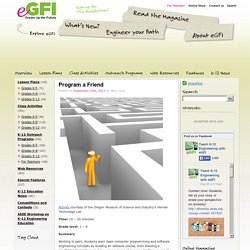
They re-run the maze to improve on the “program.” Learning objectives After doing this activity, students should be able to: Microsoft Word - Rover Races 3rd - 5th Grade Lesson.docx - Rover Races 3rd - 5th Grade Lesson.pdf. Scratch - Imagine, Program, Share. Hopscotch, Programming Designed for Everyone: coding for kids on the App Store.
Curious Little Apps. Overview As technology progresses the need for computing and coding skills rises and the developers of this app have responded by creating a kid-friendly app called Kodable.
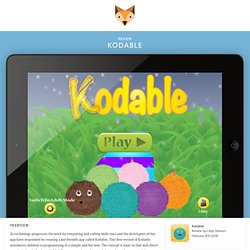
This free version of Kodable introduces children to programming in a simple and fun way. The concept is basic in that kids direct cute little fuzz balls through 30 different mazes by problem solving and creating sequential instructions for them. Throughout the app the mazes become more difficult and kids are required to ‘think’ more and more like programmers. We agree with SurfScore in that the earlier children are exposed to the world of programming the better. Learning outcome Kodable improves children’s problem solving ability through encouraging them to visualise and plan sequences of events.
Engineering is Elementary Store. Examples-Design%20Challenge%20for%20Elementary-%202013-UA-STEM-PROBLEM-SOLVING-ACTIVITIES.pdf. Elementary and Middle School Lesson Plans, The Engineering Place (K-20 Outreach), NC State University. Curious George STEM.